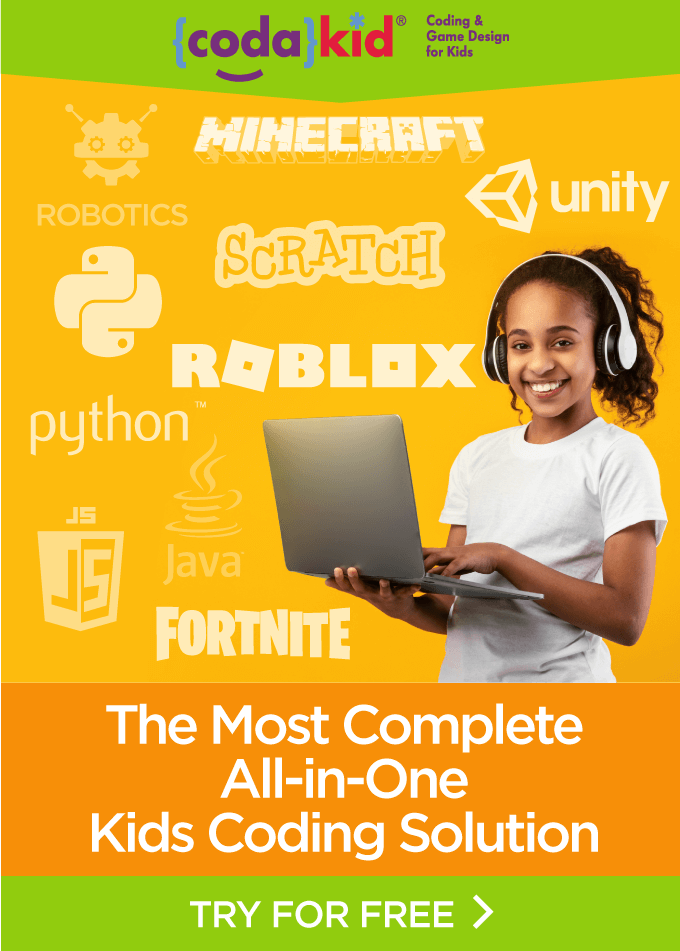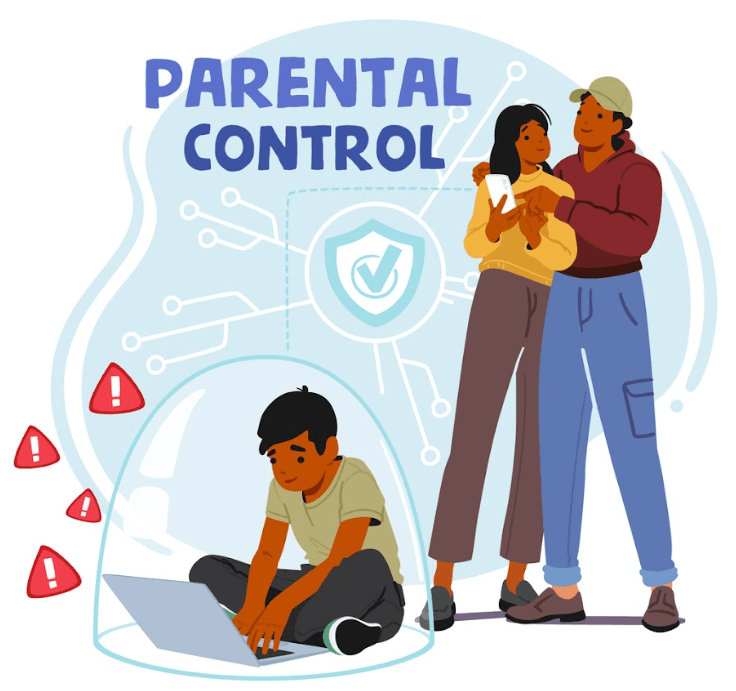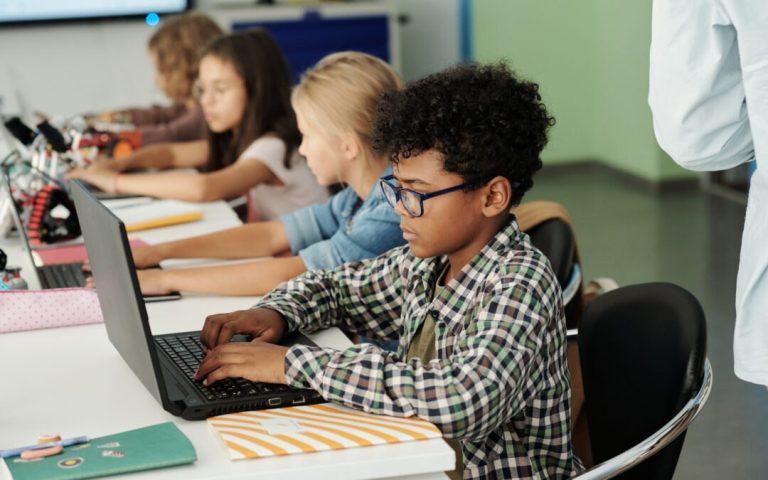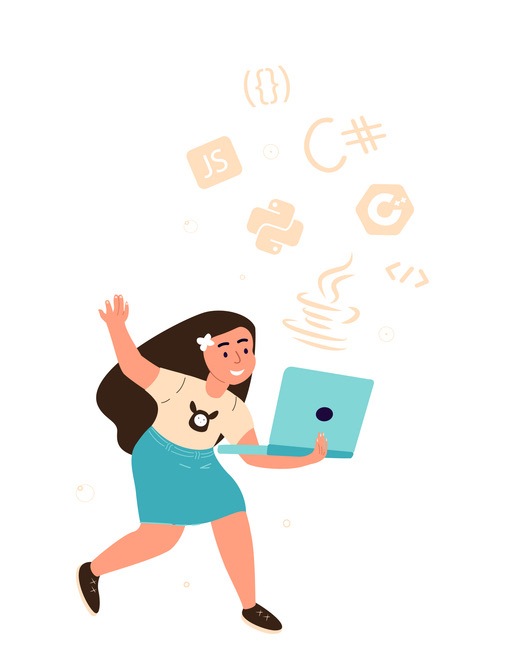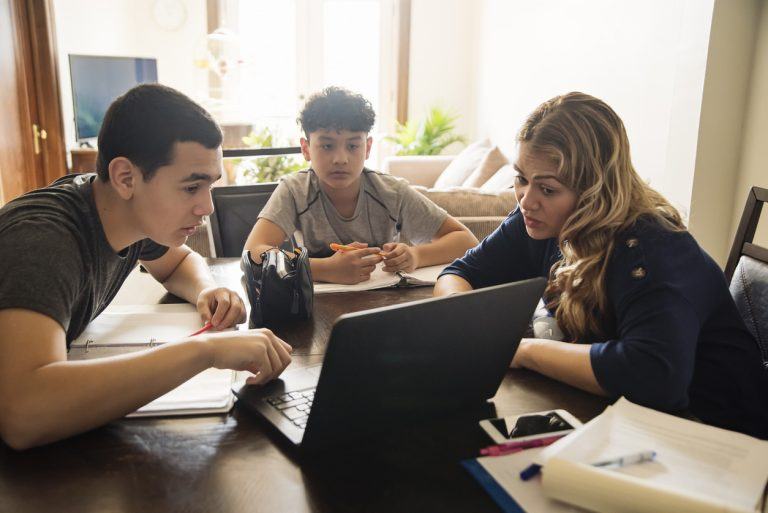Table of Contents
Coding for 10-year-olds
Ten is a perfect age to learn computer programming as students generally have a solid enough foundation in mathematics to understand algorithms and enough experience with computer keyboards to navigate more intricate coding tools.
This guide will provide you with what we at CodaKid have learned providing coding classes to thousands of 10-year-old students over the past decade. We hope that you’ll find it helpful.
General recommendations
- We recommend visual block programming for any 10-year-old who is just getting started. Our favorite visual block platform (described in more detail below) is Scratch.
- We highly recommend gearing the coding curriculum around the 10-year-old’s area of interest, whether it be making games, robotics, or creating interactive stories and art. We caution you to not make it too academic for this age group.
- We recommend private or small group lessons for most 10-year-olds as they will work well with a live teacher and get real time help when they get stuck. For students who are self-starters or for homeschool students who would like to devote multiple hours per week to coding, self-study platforms are the most affordable, high quality options.
- When selecting any service, carefully review the academy’s track record and reviews. Many services will provide free trials which will allow you to try before you commit.
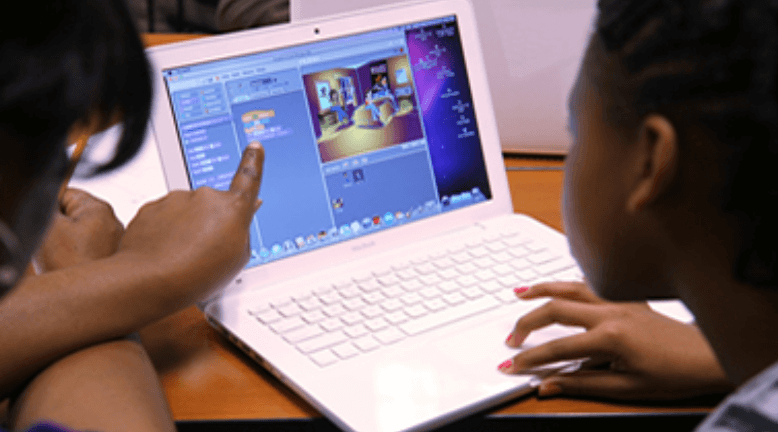
Recommended Learning Pathways
1) Scratch
Scratch is a free kids coding platform invented by Mitch Resnik and his team at MIT. Scratch uses visual block coding which enables beginners to build complex 2D games, interactive stories, and animations without typing text-based code. Scratch is one of our favorite kids coding resources for 10-year-olds as it lets kids become creators, it teaches the foundations of computer science, and it allows students to share their creations with the Scratch community, get comments, and gain followers. Our 10-year-old daughter loves Scratch and checking her projects’ likes and comments is one of the first things she does every morning. I cannot recommend this tool highly enough.
Once students have mastered Scratch, they will often want to experience text based coding and Python is one of the most accessible and easiest programming languages for beginners. It is also one of the fastest growing languages in the world and is used widely in AI, machine learning, web development, fintech, data science, and data analysis. For 10-year-old learners, Python programming can be used to make games, art projects, and other fun applications, and the simplicity of its syntax makes it one of our top choices for text based coding. We especially love using Turtle Graphics and Pygame as frameworks that allow kids to build their first projects. For an example of what a Pygame project might look like check out this video.
For students who want to learn about both coding and 3D game design, Roblox Studio is an excellent option. Roblox Studio is a free game creation engine that allows users to not only create their own 3D games but also monetize them. In our experience, Roblox is a “carrot – stick” method of teaching 10-year-old students coding foundations. Most already love Roblox, and when they find out that they can build their own custom Roblox game, they will be highly motivated to learn Lua, an elegant scripting language that is easy to learn and a transferable skill.
4) Minecraft Modding with MCreator and Java
Similar to the carrot stick approach with Roblox coding, Minecraft Modding is a wonderful way to inspire young learners to code. Minecraft “Modding” stands for modifying the source code of Minecraft and making custom additions to the game. There are several kids coding platforms that teach Minecraft Modding, but our favorite techniques involve starting with MCreator and later using Java. We’ll discuss this more in our curriculum section below.
5) Robotics with Blockly and Arduino
Robotics is a fun way to make coding physical and tactile. For 10-year-olds there are some excellent robotics kits with visual block coding as well as text based coding languages such as Python and Arduino. Some robotics kits come fully built, but our favorites (listed in the curriculum section below) require building which makes for an excellent project for inquisitive 10-year-olds.
Recommended Educational Services and Coding Curricula for 10-Year-Olds
1) CodaKid – A great All-in-One solution that provides instruction using Scratch, Roblox coding, Minecraft Modding, Python programming, Fortnite coding with Unreal Engine, Unity, and Robotics. What really makes CodaKid stand apart is that it uses professional languages and tools CodaKid has two ways to learn. The Self-Study program uses kids’ preferred way to learn (video tutorials) led by humorous, young engineers who start with the very basics and lead you through progressively more challenging material. The Private Online Lessons program matches you with a live CodaKid instructor who meets with your child each week and provides a more structured, personalized experience. CodaKid has a decade of experience specializing in kids coding and has taught over 50,000 students. CodaKid offers a free trial of both of its kids coding programs.
2) Coding with Kids – Coding with Kids offers high-quality online group classes as well as in-person classes and camps in several large markets throughout the US. Coding with Kids “Coding Ladder” is a well-thought structured program that takes learners from the basics of Scratch to advanced web development and even full stack development in the later levels. Coding with Kids specializes in Scratch coding, Python programming, Web Development, App Development, and more. They also offer excellent summer camps in Roblox Game Development, Python Programming, Minecraft Modding, and Scratch.
3) Code Kingdoms – CodeKingdoms provides a Minecraft and Roblox coding platform that allows both visual block and text-based coding options. They also provide video tutorials that teach kids how to make fun Minecraft mods and Roblox levels. The prerecorded video instruction is with a British accent which might throw some North American students off, but the platform itself is fun and engaging and we recommend checking it out.
4) Makeblock MBot Robot Kits – Mbot is one of our favorite robotics kits in that it allows 10-year-olds to learn electronics, robotics, and computer programming in a simple and engaging way. Allowing coding with both Scratch and Arduino,mBot makes for the perfect STEM robotics resource for kids ages 8-12 helps them learn programming step by step through interactive software and learning resources. We love the creative problem solving activities that you can create with mBot. For example, we have used it to create obstacle courses in which the kids need to code to guide the robot around various obstacles and to return to its starting position.

Conclusion
In summary, there are many excellent resources for teaching coding for 10-year-olds. We encourage you to Google some of the resources we have provided and perhaps even show them to your child to see which look of the most interest.
Age 10 is a fantastic age to introduce kids to computer programming, as they have a solid foundation in reading, mathematics, and problem solving – and they are naturally curious and enthusiastic about creating games, apps, and other projects with technology.
Did we miss any resources that you’ve found helpful for your 10 year old? Please leave a comment below and we’ll be sure to update the blog with reader comments!

